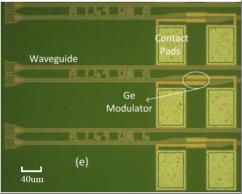Apr 2 2015
At OFC 2015, the largest global conference and exposition for optical communications, nanoelectronics research center imec, its associated lab at Ghent University (Intec), and Stanford University have demonstrated a compact germanium (Ge) waveguide electro-absorption modulator (EAM) with a modulation bandwidth beyond 50GHz.
 PB Demonstration of 50GHz Ge Waveguide Electro-Absorption Modulator
PB Demonstration of 50GHz Ge Waveguide Electro-Absorption Modulator
Combining state-of-the-art extinction ratio and low insertion loss with an ultra-low capacitance of just 10fF, the demonstrated EAM marks an important milestone for the realization of next-generation silicon integrated optical interconnects at 50Gb/s and beyond.
Future chip-level optical interconnects require integrated optical modulators with stringent requirements for modulation efficiency and bandwidth, as well as for footprint and thermal robustness. In the presented work, imec and its partners have improved the state-of-the-art for Ge EAMs on Si, realizing higher modulation speed, higher modulation efficiency and lower capacitance. This was obtained by fully leveraging the strong confinement of the optical and electrical fields in the Ge waveguides, as enabled in imec’s 200mm Silicon Photonics platform. The EAM was implemented along with various Si waveguide devices, highly efficient grating couplers, various active Si devices, and high speed Ge photodetectors, paving the way to industrial adoption of optical transceivers based on this device.
“This achievement is a milestone for realizing silicon optical transceivers for datacom applications at 50Gb/s and beyond,” stated Joris Van Campenhout, program director at imec. “We have developed a modulator that addresses the bandwidth and density requirements for future chip-level optical interconnects.”
Companies can benefit from imec’s Silicon Photonics platform (iSiPP25G) through established standard cells, or by exploring the functionality of their own designs in Multi-Project Wafer (MPW) runs. The iSiPP25G technology is available via ICLink services and MOSIS, a provider of low-cost prototyping and small volume production services for custom ICs.